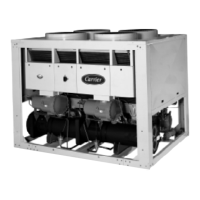14
9.6 - Cooler flow rate (l/s)
30HXC Min.* Max.**
080-090 5.7 22.7
100 6.0 24.1
110 6.9 27.5
120-130 8.3 33.0
140-155 10.0 39.5
175-190 10.7 42.7
200 13.4 53.7
230 13.4 60.6
260-285 17.0 68.1
310 19.4 77.8
345-375 21.3 85.3
30GX Min.* Max.**
082 5.7 22.7
092-102 6.0 24.1
112-122 6.9 27.5
132 8.4 33.7
152-162 10.0 39.9
182 10.7 42.7
207-227 13.4 53.7
247 15.1 60.6
267 17.0 68.1
298 19.4 77.8
328-358 21.3 85.3
* Based on a water velocity of 0.9 m/s.
** Based on a water velocity of 3.6 m/s.
9.7 - Condenser flow rate (l/s)
30HXC Min.* Max.**
Closed Open
loop loop
080-110 2.5 7.5 29.9
120-130 3.1 9.3 37.3
140-155 3.8 11.4 45.5
175-190 4.6 13.8 55.2
200 5.0 14.9 59.6
230-285 6.7 20.1 80.3
310-375 7.3 22.0 88.0
* Based on a water velocity of 0.3 m/s in a closed loop and 0.9 m/s in an open
loop.
** Based on a water velocity of 3.6 m/s.
9.4 - Variable flow evaporator
Variable evaporator flow can be used in standard 30HXC and
30GX chillers. The chillers maintain a constant leaving water
temperature under all flow conditions. For this to happen, the
minimum flow rate must be higher than the minimum flow
given in the table of permissible flow rates and must not vary
by more than 10% per minute. If the flow rate changes more
rapidly, the system should contain a minimum of 6.5 liters of
water per kW instead of 3.25 l/kW.
9.5 - System minimum water volume
Whichever the system, the water loop minimum capacity is
given by the formula:
Capacity = Cap (kW) x N Liters
Application N
Normal air conditioning 3.25
Process type cooling 6.5
Where Cap is the nominal system cooling capacity (kW) at the
nominal operating conditions of the installation.
This volume is necessary for stable operation and accurate
temperature control.
It is often necessary to add a buffer water tank to the circuit in
order to achieve the required volume. The tank must itself be
internally baffled in order to ensure proper mixing of the liquid
(water or brine). Refer to the examples below.
NOTE: The compressor must not restart more than 6 times in
an hour.
BAD
GOOD BAD GOOD

